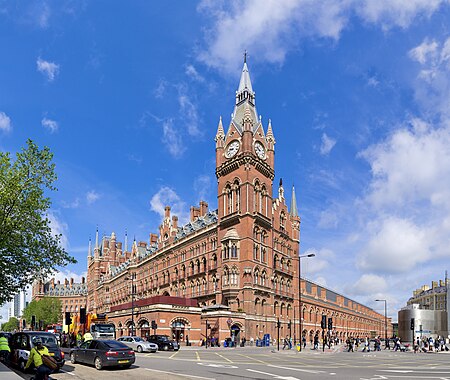St Pancras railway station

St Pancras railway station (), also known as London St Pancras or St Pancras International and officially since 2007 as London St Pancras International, is a central London railway terminus on Euston Road in the London Borough of Camden. It is the terminus for Eurostar services from Belgium, France and the Netherlands to London. It provides East Midlands Railway services to Leicester, Corby, Derby, Sheffield and Nottingham on the Midland Main Line, Southeastern high-speed trains to Kent via Ebbsfleet International and Ashford International, and Thameslink cross-London services to Bedford, Cambridge, Peterborough, Brighton and Gatwick Airport. It stands between the British Library, the Regent's Canal and London King's Cross railway station, with which it shares a London Underground station, King's Cross St Pancras. The station was constructed by the Midland Railway (MR), which had an extensive rail network across the Midlands and the North of England, but no dedicated line into London. After rail traffic problems following the 1862 International Exhibition, the MR decided to build a connection from Bedford to London with its own terminus. The station was designed by William Henry Barlow and constructed with a single-span iron roof. Following the station's opening on 1 October 1868, the MR constructed the Midland Grand Hotel on the station's façade, which has been widely praised for its architecture and is now a Grade I listed building along with the rest of the station. In the late 1960s, plans were made to demolish St Pancras entirely and divert services for King's Cross and Euston, leading to fierce opposition. The complex underwent an £800 million refurbishment to become the terminal for the Channel Tunnel Rail Link/High-Speed 1/HS1 as part of an urban regeneration plan across East London, which was opened by Queen Elizabeth II in November 2007. A security-sealed terminal area was constructed for Eurostar services to mainland Europe via High Speed 1 and the Channel Tunnel, with platforms for domestic trains to the north and south-east of England. The restored station has 15 platforms, a shopping centre, and a coach facility. London St Pancras International is owned by HS1 Ltd and managed by Network Rail (High Speed), a subsidiary of Network Rail.
Excerpt from the Wikipedia article St Pancras railway station (License: CC BY-SA 3.0, Authors, Images).St Pancras railway station
Euston Road, London King's Cross (London Borough of Camden)
Geographical coordinates (GPS) Address Website Nearby Places Show on map
Geographical coordinates (GPS)
| Latitude | Longitude |
|---|---|
| N 51.53 ° | E -0.12527777777778 ° |
Address
St Pancras Renaissance London Hotel
Euston Road
NW1 2AR London, King's Cross (London Borough of Camden)
England, United Kingdom
Open on Google Maps










